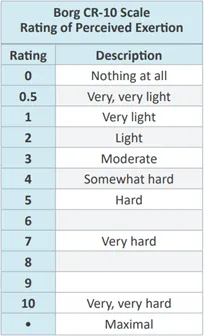When completing an ergonomics assessment, it isn’t always possible to directly measure the force being applied during a task. Fortunately, there is a widely used and scientifically validated method that can be used when direct measuring of force isn’t possible. The Borg CR-10 scale was developed by Swedish researcher, Gunner Borg, to measure exertion or effort during physical work. It’s a category-ratio scale, which means it uses a numerical intensity scale (i.e., ratio) anchored with verbal descriptors (i.e., category).
What Is the Borg CR-10 Scale?
The Borg CR-10 scale has been used in ergonomics, medicine, psychology, sports, and epidemiological research for over forty years. In ergonomics, the Borg CR-10 scale is used to quantify how heavy or strenuous a physical task is when measuring complex exertions that cannot be accurately measured using a standard force gauge or when getting a direct measurement is not safe, feasible, or possible. The scale uses 0-10 ratings, where 0 represents no exertion at all, and 10 represents maximum exertion ever experienced. When needed, it is possible to choose a number larger than 10 to represent the absolute maximum or highest possible exertion.

Important Notes for the Borg CR-10 Scale
You need to clearly define the exertion or task being rated.
Rate the exertion right after completing the task, while the experience is fresh. This helps ensure that the person rates the exertion accurately, from what they experience and not what they think the rating should be.
Confirm that the rater understands the scales and ask simple questions to gauge their understanding. There are no correct answers, but if their responses are very different from the answers below, they may need additional explanation:
- What is the highest physical exertion you have experienced in your life? This would be Very Hard/10 on the scale.
- How would you rate heavy exercise in which it is a challenge and you’re tired, but you don’t have great difficulty with? That would be Hard/5 on the scale.
- How much exertion would you feel when walking a short distance at your own pace? This would be Light/1-2.5 on the scale.
- Consider the verbal descriptors first. Which descriptor best describes the exertion? Then choose a number rating based on the descriptor that best describes the exertion. For example, if a task is between hard and very hard, choose a rating of 6. In general, the rater can use half-points (ex: 2.5, 3.5) to describe the level of force.
What Can I Do with My Results from the Borg CR-10 Scale?
Like any other data gathered, it’s only valuable if you do something with it. VelocityEHS Industrial Ergonomics allows users to enter both measured and estimated force measurements into the software, gathered using specific force measurement tools and perceived exertions based on Borg CR-10. The measured force is just that, measured in pounds (lb.) or kilograms (kg). The estimated force is a chosen rating on the Borg CR-10 scale, which the software then converts to a measured force. Perceived exertions are converted to measured forces, which allows you to compare measured and estimated forces when investigating job risk directly.
References:
- Borg, G. A. (1982). Psychophysical bases of perceived exertion. Medicine & science in sports & exercise.
- Borg, G. (1998). Borg’s perceived exertion and pain scales. Human kinetics.
